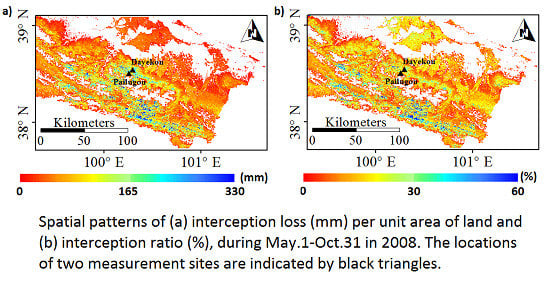Developing the Remote Sensing-Gash Analytical Model for Estimating Vegetation Rainfall Interception at Very High Resolution: A Case Study in the Heihe River Basin
Abstract
:1. Introduction
2. Study Area and Data
2.1. Study Area
2.2. Data
2.2.1. In Situ Measurements of Vegetation Rainfall Interception
2.2.2. Forcing Data
2.2.3. Remote Sensing Data
3. Methods
3.1. RS-Gash Analytical Model
- (1)
- (2)
- Calculate evaporation using the Penman-Monteith model [16] using the hourly forcing data from WRF model:where E (kg m−2 s−1) is the evaporation rate; λ (J kg−1) is the latent heat of vaporization; ra (s m−1) is the aerodynamic resistance; Rn (W m−2) is the net radiation; cp (J kg−1 K−1) is the specific heat capacity of air at constant pressure; D (Pa) is the vapor pressure deficit; γ (Pa K−1) is the psychrometric constant; ∆ (Pa K−1) is the slope of the saturation vapor pressure curve at air temperature; and ρ (kg m−3) is the density of air;λE = (∆Rn + ρcpD/ra)(∆ + γ)−1
- (3)
- The vegetation storage capacity and FVC are obtained based on VAI retrieved from very high resolution remote sensing image (see Section 3.2);
- (4)
- Finally, the vegetation rainfall interception is calculated from the RS-Gash model with parameters and input variables acquired in the previous several steps.
3.2. VAI Retrieval Model and FVC
4. Results
4.1. Field Validation
4.2. The Variation of Interception across Different Vegetation Types
4.3. The Relationship between Interception and Precipitation
5. Discussion
6. Conclusions
Acknowledgments
Author Contributions
Conflicts of Interest
References
- Li, X.; Li, X.; Li, Z.; Ma, M.; Wang, J.; Xiao, Q.; Liu, Q.; Che, T.; Chen, E.; Yan, G.; et al. Watershed Allied Telemetry Experimental Research. Watershed Allied Telemetry Experimental Research. J. Geophys. Res. Atmos. 2009, 114. [Google Scholar] [CrossRef]
- Herbst, M.; Rosier, P.T.W.; McNeil, D.D.; Harding, R.J.; Gowing, D.J. Seasonal variability of interception evaporation from the canopy of a mixed deciduous forest. Agric. For. Meteorol. 2008, 148, 1655–1667. [Google Scholar] [CrossRef]
- Van Dijk, A.I.J.M.; Bruijnzeel, L.A. Modelling rainfall interception by vegetation of variable density using an adapted analytical model. Part 2. Model validation for a tropical upland mixed cropping system. J. Hydrol. 2001, 247, 239–262. [Google Scholar] [CrossRef]
- Levia, D.F.; Frost, E.E. Variability of throughfall volume and solute inputs in wooded ecosystems. Prog. Phys. Geogr. 2006, 30, 605–632. [Google Scholar] [CrossRef]
- Miralles, D.G.; Gash, J.H.; Holmes, T.R.H.; de Jeu, R.A.M.; Dolman, A.J. Global canopy interception from satellite observations. J. Geophys. Res. Atmos. 2010, 115. [Google Scholar] [CrossRef]
- Mo, X.G.; Liu, S.X.; Lin, Z.H.; Zhao, W.M. Simulating temporal and spatial variation of evapotranspiration over the Lushi basin. J. Hydrol. 2004, 285, 125–142. [Google Scholar] [CrossRef]
- Gash, J.H.C.; Lloyd, C.R.; Lachaud, G. Estimating Sparse Forest Rainfall Interception with an Analytical Model. J. Hydrol. 1995, 170, 79–86. [Google Scholar] [CrossRef]
- Cui, Y.; Jia, L. A Modified Gash Model for Estimating Rainfall Interception Loss of Forest Using Remote Sensing Observations at Regional Scale. Water 2014, 6, 993–1012. [Google Scholar] [CrossRef]
- Li, X.; Cheng, G.D.; Liu, S.M.; Xiao, Q.; Ma, M.G.; Jin, R.; Che, T.; Liu, Q.H.; Wang, W.Z.; Qi, Y.; et al. Heihe Watershed Allied Telemetry Experimental Research (HiWATER): Scientific Objectives and Experimental Design. Bull. Am. Meteorol. Soc. 2013, 94, 1145–1160. [Google Scholar] [CrossRef]
- Cui, Y.K.; Jia, L.; Hu, G.C.; Zhou, J. Mapping of Interception Loss of Vegetation in the Heihe River Basin of China Using Remote Sensing Observations. IEEE Geosci. Remote Sens. Lett. 2015, 12, 23–27. [Google Scholar]
- Pan, X.D.; Li, X.; Shi, X.K.; Han, X.J.; Luo, L.H.; Wang, L.X. Dynamic downscaling of near-surface air temperature at the basin scale using WRF-a case study in the Heihe River Basin, China. Front. Earth Sci. 2012, 6, 314–323. [Google Scholar] [CrossRef]
- Pan, X.D.; Li, X. Validation of WRF model on simulating forcing data for Heihe River Basin. Sci. Cold Arid Reg. 2011, 03, 344–357. [Google Scholar]
- Kummerow, C.; Simpson, J.; Thiele, O.; Barnes, W.; Chang, A.T.C.; Stocker, E.; Adler, R.F.; Hou, A.; Kakar, R.; Wentz, F.; et al. The status of the Tropical Rainfall Measuring Mission (TRMM) after two years in orbit. J. Appl. Meteorol. 2000, 39, 1965–1982. [Google Scholar] [CrossRef]
- Huffman, G.J.; Adler, R.F.; Bolvin, D.T.; Gu, G.J.; Nelkin, E.J.; Bowman, K.P.; Hong, Y.; Stocker, E.F.; Wolff, D.B. The TRMM multisatellite precipitation analysis (TMPA): Quasi-global, multiyear, combined-sensor precipitation estimates at fine scales. J. Hydrometeorol. 2007, 8, 38–55. [Google Scholar] [CrossRef]
- Xu, X.; Fan, W.; Li, J.; Zhao, P.; Chen, G. A unified model of bidirectional reflectance distribution function for the vegetation canopy. Sci. China Earth Sci. 2017, 60, 463–477. [Google Scholar] [CrossRef]
- Monteith, J.L. Evaporation and environment. Symp. Soc. Exp. Biol. 1965, 19, 205–223. [Google Scholar] [PubMed]
- Liao, Y.; Fan, W.; Xu, X. Algorithm of Leaf Area Index Product for HJ-CCD over Heihe River Basin. In Proceedings of the 2013 IEEE International Geoscience and Remote Sensing Symposium (IGARSS), Melbourne, Australia, 21–26 July 2013; pp. 169–172. [Google Scholar]
- Cui, Y.K.; Zhao, K.G.; Fan, W.J.; Xu, X.R. Retrieving crop fractional cover and LAI based on airborne Lidar data. J. Remote Sens. 2011, 15, 1276–1288. [Google Scholar]
- Muzylo, A.; Llorens, P.; Valente, F.; Keizer, J.J.; Domingo, F.; Gash, J.H.C. A review of rainfall interception modelling. J. Hydrol. 2009, 370, 191–206. [Google Scholar] [CrossRef]

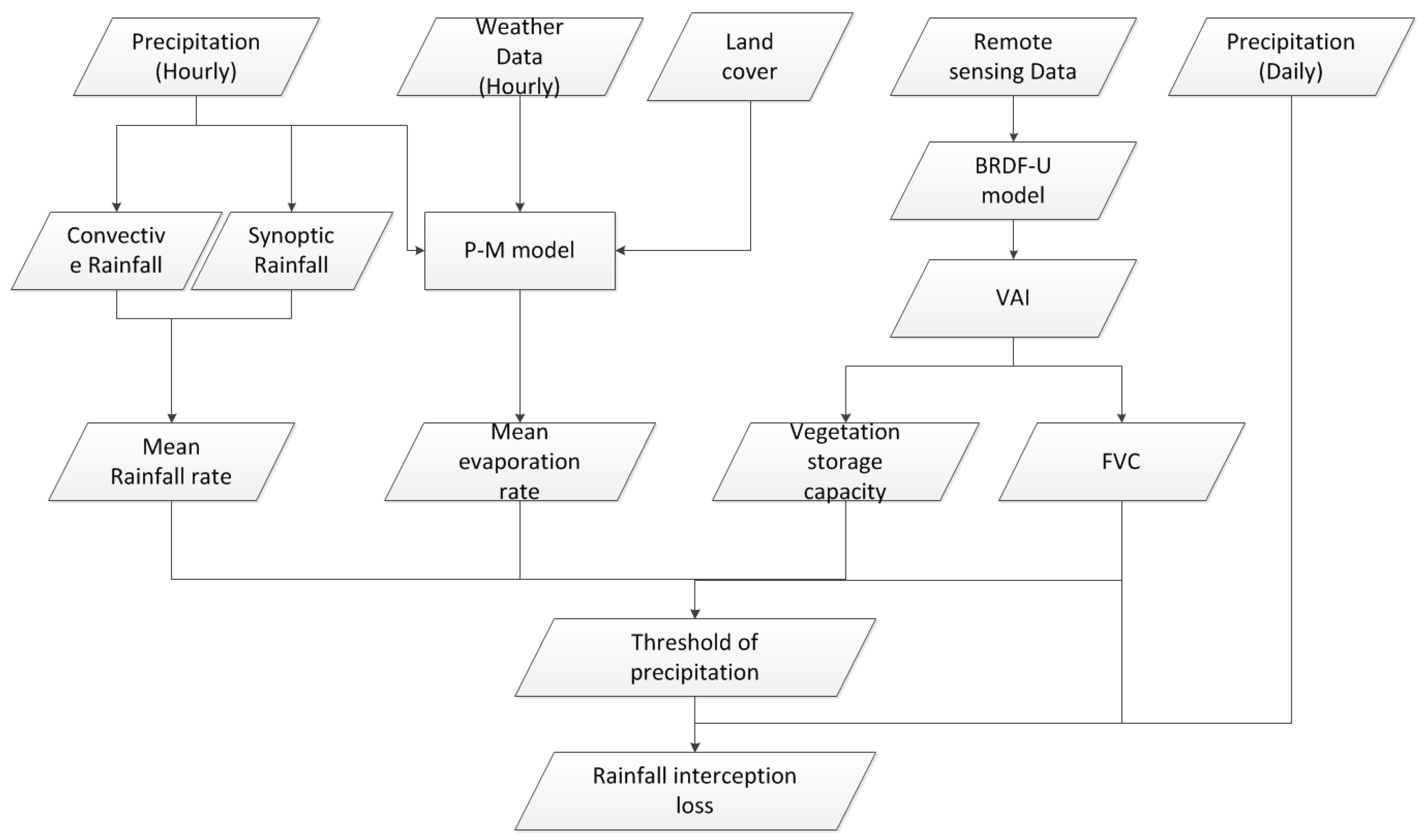
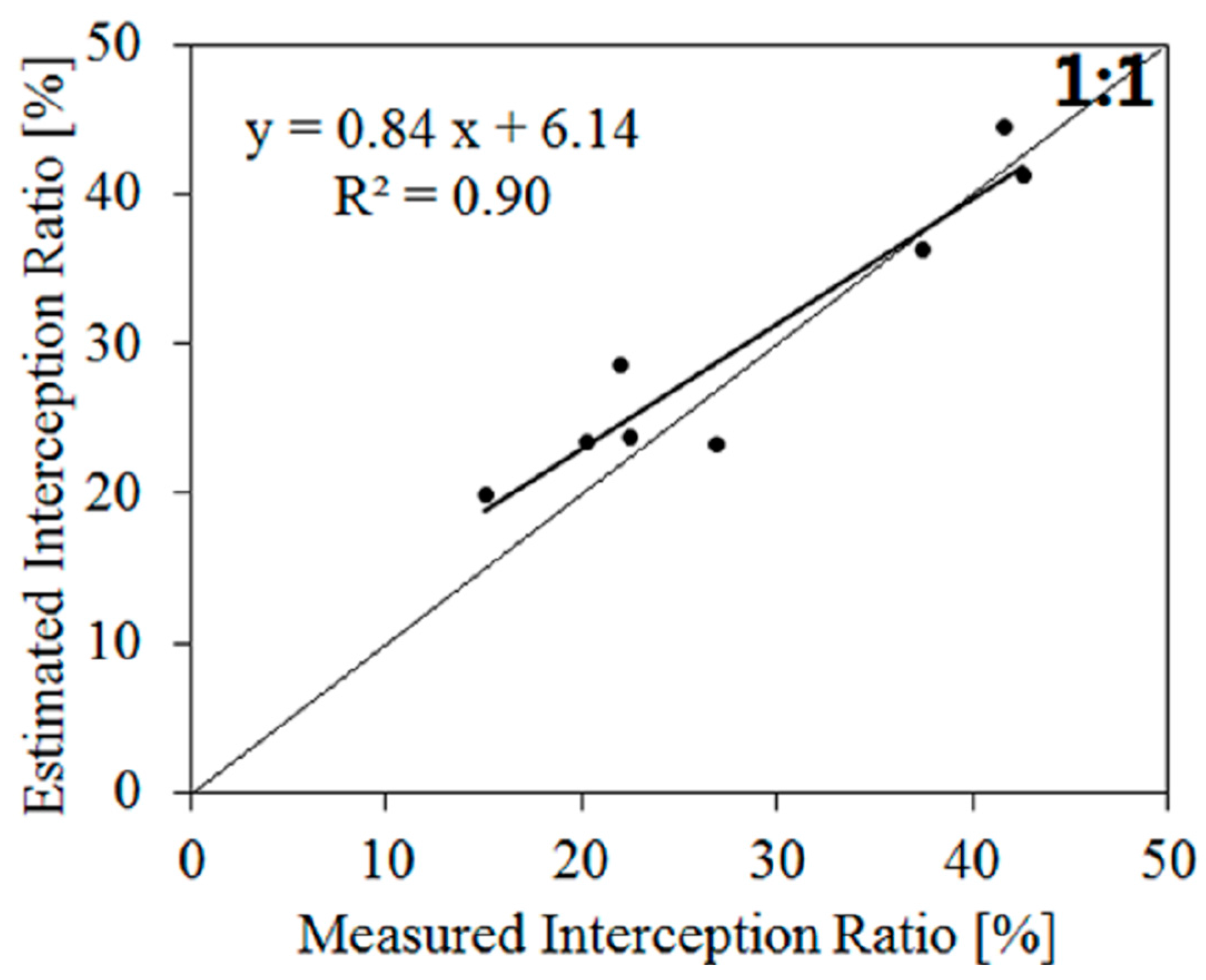
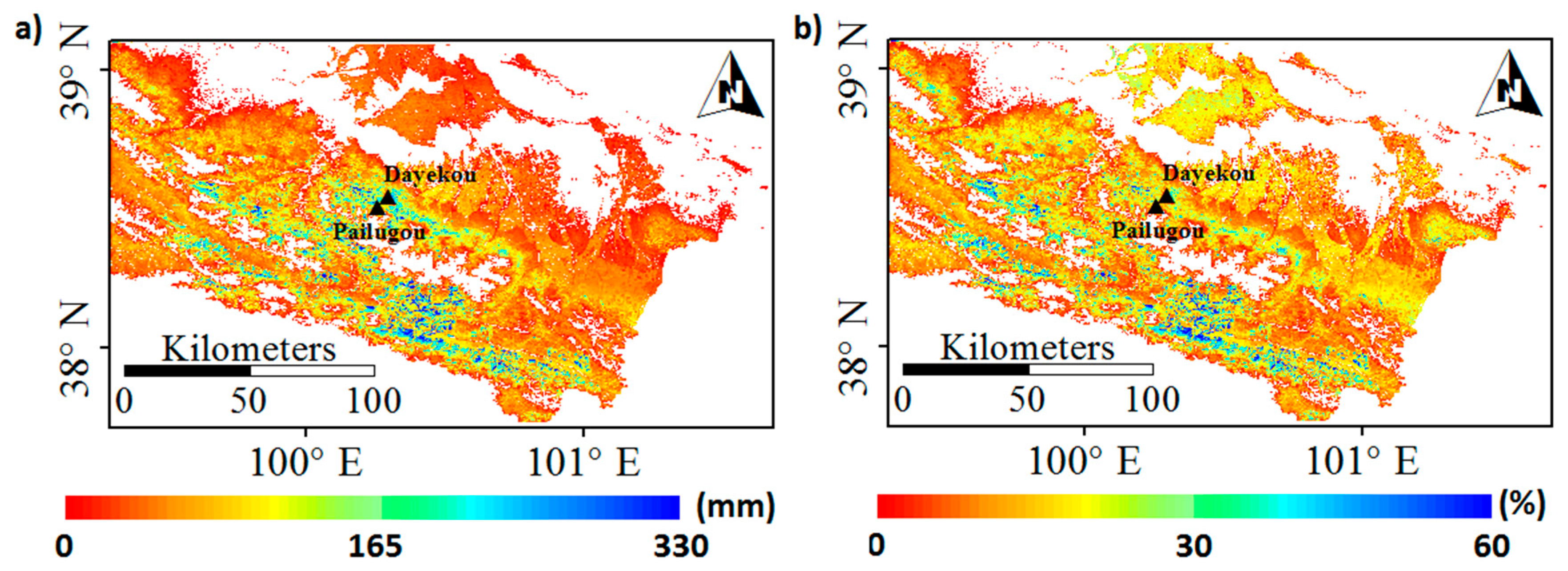


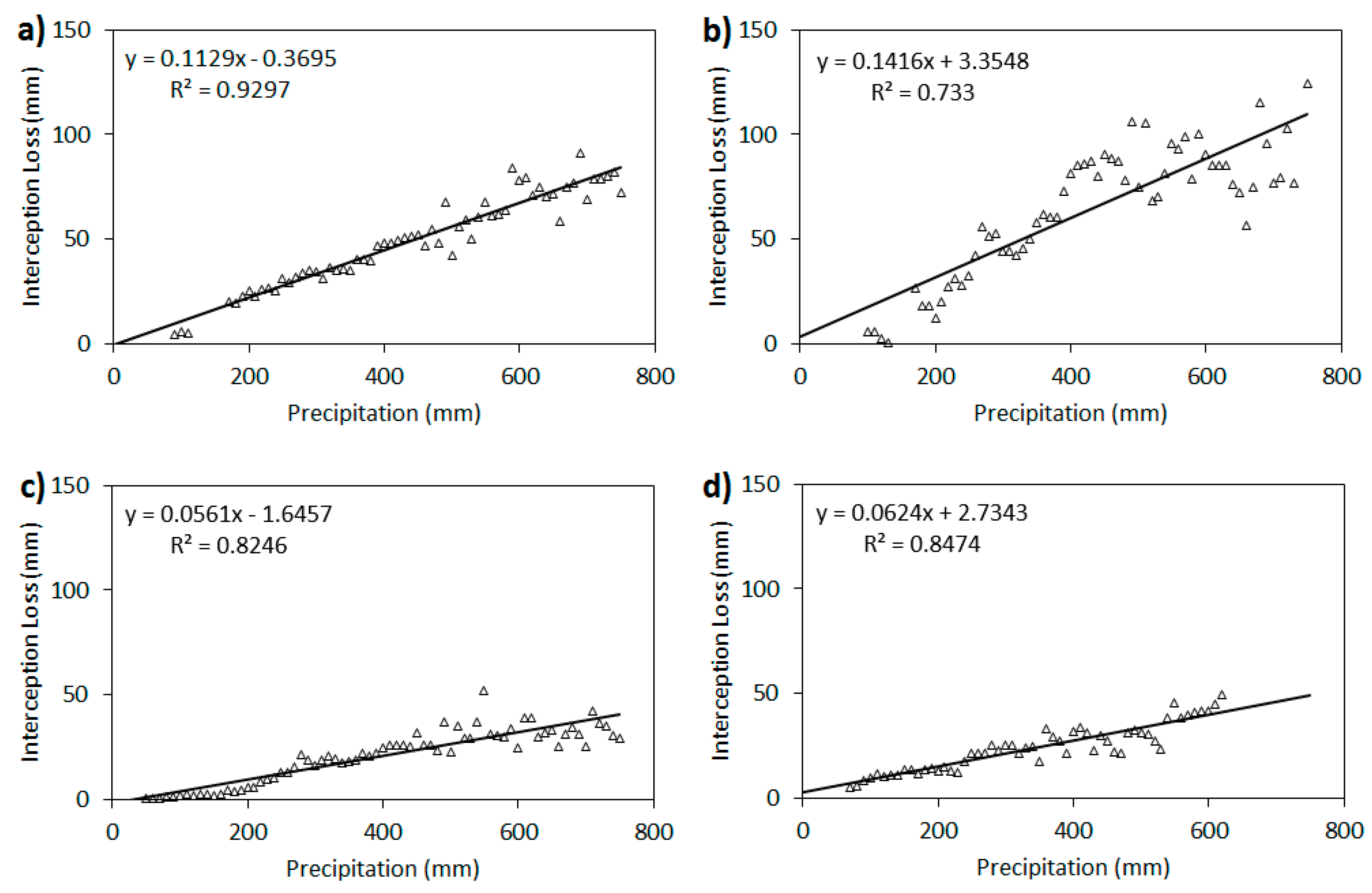
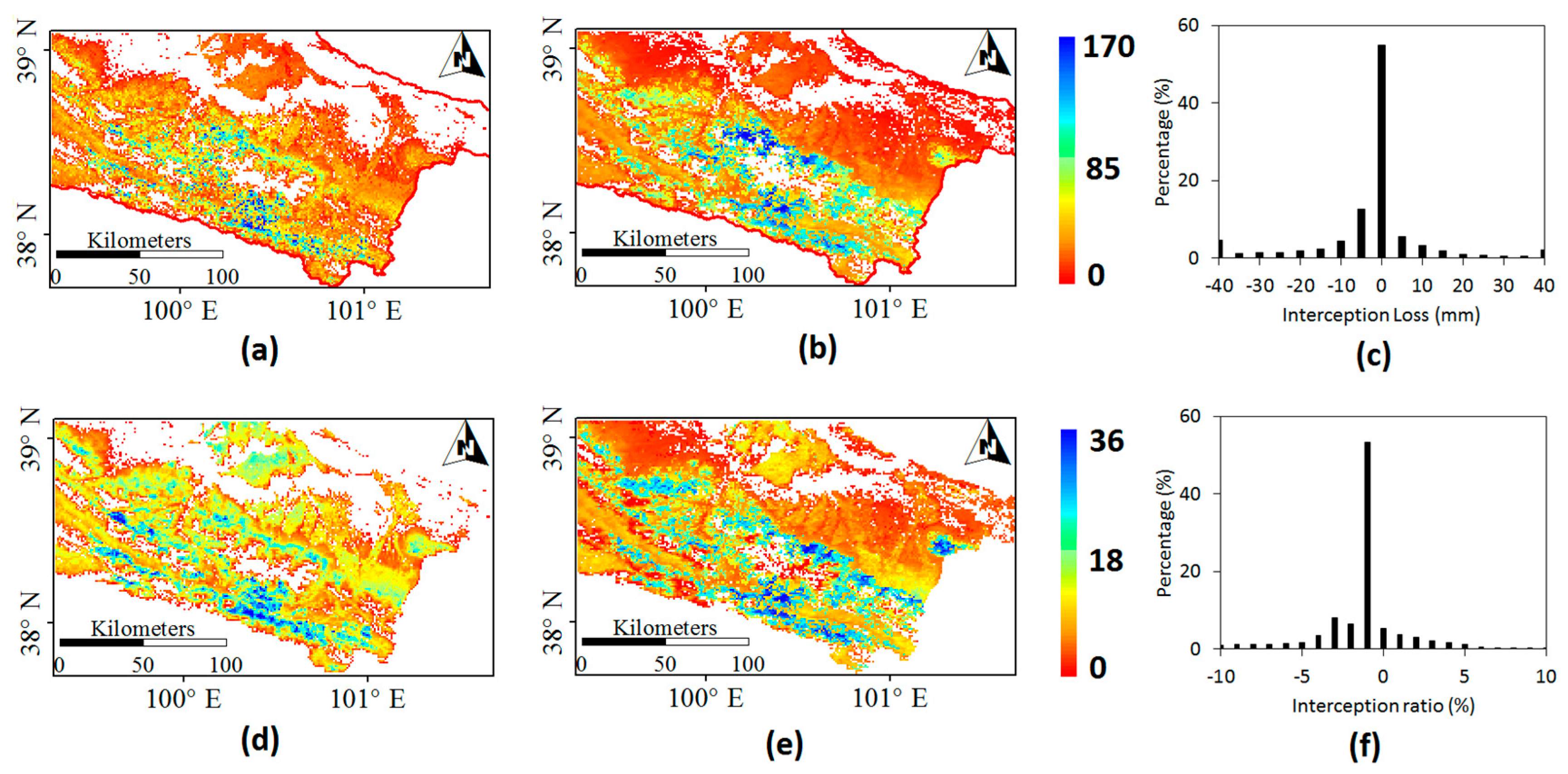
| Month/Year | Dayekou | Pailugou | ||
|---|---|---|---|---|
| Estimated | Measured | Estimated | Measured | |
| June 2008 | 26.9 | 23.2 | 41.7 | 44.5 |
| July 2008 | 20.3 | 23.4 | 37.5 | 36.3 |
| August 2008 | 15.1 | 19.9 | 42.6 | 41.3 |
| September 2008 | 22.5 | 23.7 | 22.0 | 28.5 |
| Mean | 21.2 | 22.6 | 35.9 | 37.7 |
| STD | 4.9 | 1.8 | 9.6 | 7.0 |
| RMSE | 3.46 | 3.65 | ||
| Interception Loss (mm, Fine) | Interception Loss (mm, Coarse) | Interception Ratio (%, Fine) | Interception Ratio (%, Coarse) | |
|---|---|---|---|---|
| Forest | 43.41 | 55.90 | 11.17 | 14.63 |
| Shrub | 69.06 | 60.65 | 17.31 | 15.33 |
| Crop | 20.49 | 13.30 | 5.61 | 4.37 |
| Grass | 16.11 | 10.47 | 7.48 | 4.79 |
© 2017 by the authors. Licensee MDPI, Basel, Switzerland. This article is an open access article distributed under the terms and conditions of the Creative Commons Attribution (CC BY) license (http://creativecommons.org/licenses/by/4.0/).
Share and Cite
Cui, Y.; Zhao, P.; Yan, B.; Xie, H.; Yu, P.; Wan, W.; Fan, W.; Hong, Y. Developing the Remote Sensing-Gash Analytical Model for Estimating Vegetation Rainfall Interception at Very High Resolution: A Case Study in the Heihe River Basin. Remote Sens. 2017, 9, 661. https://doi.org/10.3390/rs9070661
Cui Y, Zhao P, Yan B, Xie H, Yu P, Wan W, Fan W, Hong Y. Developing the Remote Sensing-Gash Analytical Model for Estimating Vegetation Rainfall Interception at Very High Resolution: A Case Study in the Heihe River Basin. Remote Sensing. 2017; 9(7):661. https://doi.org/10.3390/rs9070661
Chicago/Turabian StyleCui, Yaokui, Peng Zhao, Binyan Yan, Hongjie Xie, Pengtao Yu, Wei Wan, Wenjie Fan, and Yang Hong. 2017. "Developing the Remote Sensing-Gash Analytical Model for Estimating Vegetation Rainfall Interception at Very High Resolution: A Case Study in the Heihe River Basin" Remote Sensing 9, no. 7: 661. https://doi.org/10.3390/rs9070661




